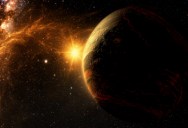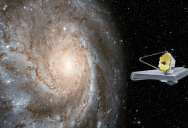How NASA Thinks The Sun Could Function As A Giant Telescope

NASA is full of big and challenging ideas.
The cool thing about that is sometimes, after hard work and collaboration and failures, it actually all comes to fruition.
Now, they’re wondering whether or not the Sun could function as a telescope of sorts, allowing us to view the surface of other planets up close.
Way back in 1936, Albert Einstein posited that the Sun could one day be used as a gigantic telescope.
Now, the concept is at phase III of NASA’s Institute for Advanced Concepts.
Einstein’s general theory of relativity implies that giant objects in the universe bend space-time, altering the path of light in the process.

This isn’t conceptual but something that happens regularly while using telescopes like the James Webb – we extend the telescope’s range by viewing light which has been bent by massive objects on its path to Earth.
This means, then, that there is a region of our Solar System where light from behind the Sun is focused after being bent by its gravity.
The affected region is around 550 Astronomical Units from the Sun. 1 Astronomical Unit is the distance between the Earth and the Sun.
So, if you place a telescope in that region, we could use it to view the surfaces of many exoplanets without the need for really, really huge space telescopes.
Von Russel Eshleman, who proposed a mission to make exactly that, penned a paper on the topic.
“The gravitational field of the Sun acts as a spherical lens to magnify the intensity of radiation from a distant source along a semi-infinite focal line. A spacecraft anywhere on that line in principle could observe, eavesdrop, and communicate over interstellar distances, using equipment comparable in size and power with what is now used for interplanetary distances. If one neglects coronal effects, the maximum magnification factor for coherent radiation is inversely proportional to the wavelength, being 100 million at 1 millimeter.”
We use gravitational lensing to see very distant objects now, but we’re limited by their location.
If we used a spacecraft to place a telescope on the opposite side of the Sun to the distant object we want to view, we would get a much larger viewing distance.

The project in phase III of NASA’s Institute for Advanced Concepts believes it could even allow us to see the surface of exoplanets in the neighborhood.
“Even in the presence of the solar corona, the signal-to-noise ratio is high enough that in six months of integration time one can reconstruct the exoplanet image with 15.5 mile-scale surface resolution, enough to see surface features and signs of habitability.”
Einstein could not have been able to dream of reaching such a distance, and with Voyager I reaching around 160 AU, even now we have a long way to go.
That said, it no longer seems out of reach.
Of course, many challenges lie ahead if NASA and others are going to be able to make this a reality. That said, the idea of having a stockpile of images of the surfaces of alien planets is a compelling future to look forward to.
I have to think Einstein would be proud.
Stunned and awed, but yeah. Also proud.
If you thought that was interesting, you might like to read about a second giant hole has opened up on the sun’s surface. Here’s what it means.

Sign up to get our BEST stories of the week straight to your inbox.




